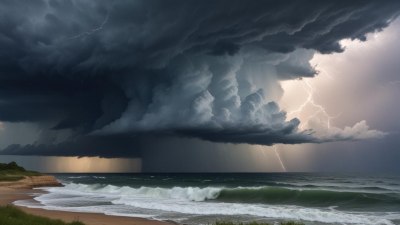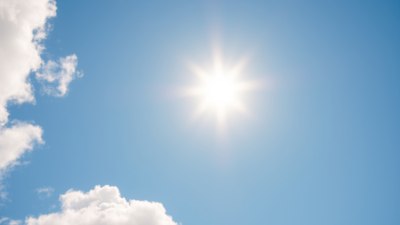When the Sky Roars: Why Thunder Sounds Different in Every Storm
Explore the science behind the varying sounds of thunder in different storms and what causes these unique acoustic signatures.

This image was created with the assistance of Freepik
Thunder is often described as one of nature's most awe-inspiring phenomena. When a storm rolls in, the crack of thunder reverberates through the air, echoing through valleys and bouncing off buildings. Yet, despite its ubiquity, the sound of thunder can vary significantly from one storm to another. This article delves into the reasons why thunder sounds different in every storm, examining factors such as distance, temperature, humidity, and storm intensity.
The Basics of Thunder
Before we explore the variations in thunder sounds, it's essential first to understand what thunder is. Thunder is essentially the sound produced by the rapid expansion and contraction of air surrounding a lightning bolt. When a bolt of lightning travels through the atmosphere, it heats the surrounding air to temperatures reaching up to 30,000 degrees Fahrenheit in mere microseconds. This sudden heating causes the air to expand explosively, creating a shock wave that we perceive as thunder. Because of this process, the core of thunder is consistent, yet what varies is how we hear it.
Distance from the Storm
One of the most significant factors affecting the sound of thunder is the distance from the observer to the storm. Thunder travels as a sound wave, which means that the further away a person is from the source, the longer it takes for the sound to reach them. This delay can lead to a noticeable difference in how thunder sounds. For instance, thunder heard from a distance often appears to be a low rumble or boom, while thunder sounded from close proximity is sharp and crackling. Additionally, the human ear perceives lower frequencies differently than higher frequencies, causing this variation in perception based on distance.
Weather Conditions Influence Acoustics
The weather conditions at the time of the storm can also greatly affect how thunder sounds. Temperature and humidity are two critical factors in this equation. Warm, moist air allows sound waves to travel further and more effectively than cooler, dry air. Consequently, thunderstorms that occur in warm, humid climates may produce a deeper, more resonant sound as the sound waves travel more efficiently. Conversely, during colder weather, thunder may seem higher-pitched and less resonant due to the diminished ability of sound waves to travel through denser strata of air.
The Role of Terrain
The geography of the area where thunder is observed plays a crucial role in modifying its sound. Sound waves can be affected by various terrains, such as hills, mountains, and valleys. For example, in mountainous regions, thunder may sound muffled or delayed as it bounces off the surrounding peaks. In contrast, areas with flat or open landscapes allow sound waves to travel unimpeded, leading to clearer, more intense thunder sounds. Additionally, urban environments filled with buildings can create an echo effect, altering the perceived sound of thunder as it reflects off various structures.
Storm Intensity and Type
Another vital factor influencing the sound of thunder is the storm's intensity and type. Severe thunderstorms tend to produce louder and more chaotic thunder sounds, as the processes involved are more violent. In a severe storm, there are often multiple strikes of lightning that generate coinciding thunder, resulting in a continuous rumble rather than distinct claps. On the other hand, lighter storms may produce only sporadic thunder, leading to pauses between sounds that can allow for clearer perceptions of individual strikes.
Frequency and Reverberation
Thunder can also vary in frequency, which can affect how we perceive the sound. Low-frequency rumbles, such as those produced by distant thunderstorms, can travel further than high-frequency sounds. This phenomenon explains why thunder can be heard from greater distances when it resonates at a lower frequency. Reverberation also contributes to how thunder sounds; when sound waves bounce off surfaces, they can create echoes that change the overall perception of the sound. The surfaces involved—such as walls, mountains, or even water bodies—can either enhance or diminish the thunder's impact.
Lightning Conditions
The nature of the lightning strike itself can also dictate the characteristics of the thunder. Different types of lightning produce varying sound profiles. For example, cloud-to-ground lightning generates a more powerful shock wave due to its direct interaction with the earth, resulting in a more pronounced clap of thunder. Conversely, intra-cloud lightning, which occurs within a cloud, may produce a more diffuse and muffled thunder sound due to the scattering of sound waves through the cloud's structure.
Cultural and Psychological Factors
Interestingly, beyond the scientific rationale, personal experience and cultural context can shape our perception and interpretation of thunder. Individuals raised in regions prone to musical storms may develop a fondness for the sound of thunder, associating it with comfort or nostalgia. In contrast, those with negative experiences related to thunderstorms may find the sound more alarming or disruptive. Furthermore, cultural folklore and storytelling often ascribe meaning to thunder, enhancing the emotional response to its sounds. This subjective interpretation can add another layer to why thunder is perceived differently across various audiences.
Environmental Impact
Lastly, environmental conditions also matter when deciphering thunder sounds. Sound waves interact with a multitude of environmental aspects, including wind patterns, atmospheric pressure, and even pollution levels. Wind can carry sound waves in certain directions, altering how they reach the listener's ear. Meanwhile, atmospheric pressure variations, such as those experienced in high-altitude regions, can change how sound waves are transmitted, leading to distinct audible experiences. On the other hand, urban pollution and noise can mask or distort thunder sounds, making it difficult to appreciate their full spectrum.
In summary, the sound of thunder is a complex interplay of various factors. Distance from the storm, weather conditions, terrain, storm intensity and type, frequency and reverberation, lightning conditions, cultural experiences, and environmental impacts all contribute to how thunder is experienced by different people across different places. Understanding these dynamics not only enriches our appreciation of thunder but also fosters a deeper connection to the natural world. Next time you hear a roar in the sky, take a moment to consider the myriad of factors that contribute to the unique and varied symphony of sound that accompanies storms.











